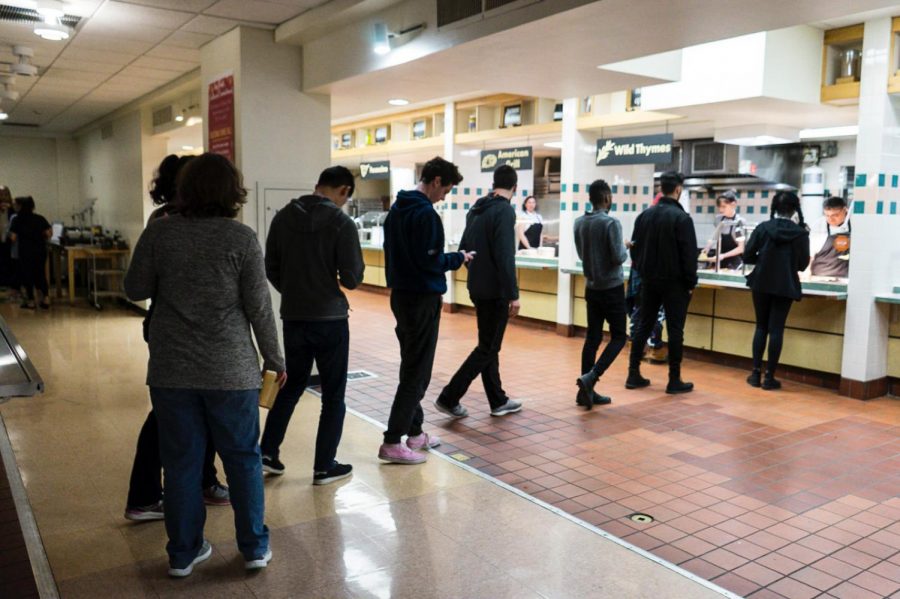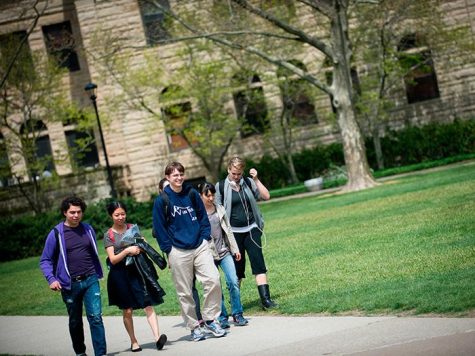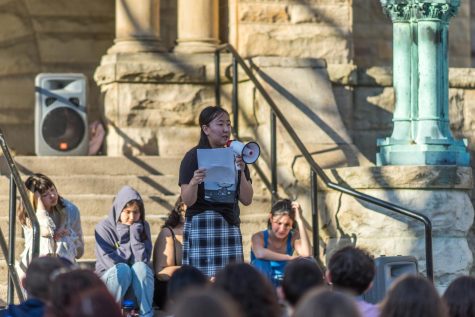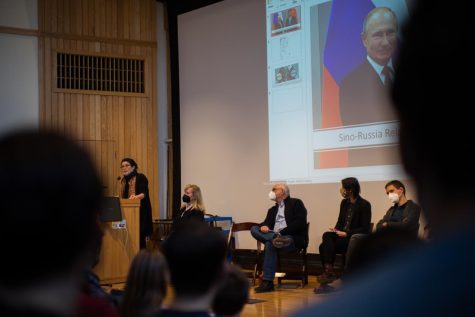Dascomb to Close, New CDS Options Introduced
Students line up to get food at Fourth Meal, which will be moved to DeCafé and the Rathskeller next fall due to the closing of Dascomb Dining Hall.
Vice President and Dean of Students Meredith Raimondo announced that Dascomb Dining Hall will close next semester in a March 12 campus-wide email. To offset the meals specific to Dascomb, both DeCafé and Lord-Saunders Dining Hall will offer breakfast, and DeCafé will host fourth meal. The administration is also looking to increase dining accessibility by extending Lord-Saunders hours and adding grab-and-go options, currently available in DeCafé, to Stevenson Dining Hall as well, which will otherwise continue operating under the same hours as the current semester.
The campus dining changes follow President Carmen Ambar’s presentations last month detailing the financial status of the College. Ambar noted in these presentations that because enrollment has dipped in recent years, it makes more fiscal sense to consolidate dining spaces to increase savings.
Raimondo said that the College will save an estimated $500,000 per year by closing Dascomb. Most of the costs come from staffing and the energy and resources it takes to operate the facility.
“Some of [the savings] is from the staffing reductions, and Oberlin runs an extremely high number of commercial kitchens for a college of its size,” Raimondo said. “They are very expensive in terms of equipment maintenance and in terms of power.”
Although Dascomb’s closure is intended to help Oberlin tackle its financial situation, Campus Dining Service workers are concerned about the loss of jobs it presents.
“I feel terrible that people are being disposed to other places,” said Valerie Hardnett, a non-union Dascomb CDS employee. “But it is a reality of life. I think people need to be prepared, have a plan, have funds saved, etc. Overall this decision to close Dascomb is about saving the institution for future generations.”
Students also said that they are upset that closing Dascomb will reduce student job opportunities and the sense of community that students find there.
“There is 100 percent a community amongst all people who work at Dascomb — among the students, chefs, and temps,” said College sophomore and Dascomb student-employee Sarah Behrend-Wilcox. “I love coming to work because I know that I’m going to love the people who I work with. Stevie just doesn’t seem to have that sense of community.”
Other students said they were concerned about dining location accessibility with the coming changes, since Dascomb is the dining hall most central to campus and closest to several academic buildings. Conservatory sophomore Gabriela Linares said she and other Conservatory students are especially worried about the distance of commuting to other dining halls with their tight practice and class schedules.
“With our demanding schedule, the most viable option for Conservatory students has always been Dascomb,” Linares said. “Having to walk to Stevie is very inconvenient because it is too far for people who have classes at 12. We are also worried about relying on DeCafé because it can get very crowded, and now it could take even longer to get food.”
Raimondo explained that the College intends to address accessibility concerns by updating dining options.
“We want to invest in Stevenson in a way that makes it more attractive for students and to make it more accessible,” she said. “One thing that I hope will happen next year is to bring some of the grab-and-go capacity to Stevenson that is currently in Wilder. Having another place where students can get that kind of lunch experience would be great.”
To address South Campus dining needs, Raimondo added that the administration is considering adding lunch options at Lord-Saunders.
“We are looking at some kind of lunch offering at Lord-Saunders, which is actually the same time difference from the Conservatory as Dascomb is,” she said. “There may be some other options as well, such as having grab-and-go options delivered to the Con or setting up some really high-quality vending machines with good, healthy food.”
DeCafé has been adjusting over this past year to expand its dining options and include more groceries, causing greater traffic during peak mealtimes. Raimondo said that the College is working to further address this challenge.
“Better traffic flow is a high priority,” Raimondo said. “We have not decided yet, but there are a bunch of different options on how can we use technology, maybe to have people pre-buy their lunch. We might consider limiting the number of design-your-own sandwich preparations during the lunch hours because it is so labor intensive. We might be able to make a by-the-ounce sandwich bar so people could make their own sandwiches.”
Despite the difficulties that emerge with the coming changes and dining restructuring, Raimondo added that those obstacles also require the College to innovate the future dining program it wants in collaboration with the community.
“Challenges create the opportunity for creativity because you can’t just keep doing what you’re doing,” she said. “My own impression is that students want more creativity in the dining program, so this could be a good way to meet students’ needs and the institutional sustainability needs. Many people involved in the dining program are pretty energized by the ability to think outside the box.”











